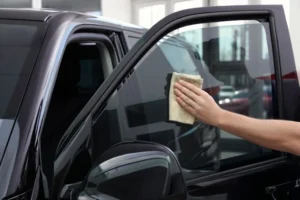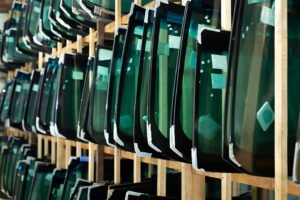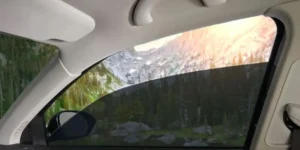A damaged windshield is more than a cosmetic flaw—it’s a critical safety hazard that demands immediate attention. For drivers in El Cajon, distinguishing between cracks and chips can mean the difference between a quick, affordable repair and a full windshield replacement. This guide dives deep into identifying windshield damage, explains repair options, and highlights why Cali Auto Glass & Tint is your trusted local expert for fast, reliable solutions.
Why Identifying Windshield Damage Matters
Ignoring windshield damage can lead to severe consequences:
- Safety Risks: Compromised structural integrity reduces protection in collisions. According to the National Highway Traffic Safety Administration (NHTSA), windshields contribute up to 30% of a vehicle’s roof strength during rollovers.
- Legal Compliance: California Vehicle Code § 26710 prohibits driving with obstructions in the driver’s line of sight, which includes certain types of windshield damage.
- Cost Savings: Repairing a small chip costs $50 –$150, while replacements range from $199 – $1,000. Delaying repairs often escalates costs.
Windshield Cracks vs. Chips: A Detailed Breakdown
Windshield Chips
Chips are small, localized damage caused by debris impacts. Common types include:
- Bullseye Chip: Circular with a dark center, resembling a target.
- Star Crack: Short cracks radiating outward from a central impact point.
- Half-Moon Chip: A partial circular shape, similar to a crescent.
- Pit Chip: A tiny, shallow divot without cracks (often caused by gravel).
Size: Typically ≤1 inch in diameter.
Repairable? Yes, if addressed promptly.
Windshield Cracks
Cracks are lines that spread due to stress, temperature changes, or untreated chips. Types include:
- Edge Crack: Starts within 2 inches of the windshield edge, often due to structural stress.
- Stress Crack: Caused by extreme temperature shifts—common in San Diego’s coastal climate, where summer heat meets cooler nights.
- Floating Crack: Begins away from the windshield edge, often from untreated chips.
- Combination Break: A mix of cracks and chips, complicating repairs.
Size: Ranges from hairline fractures to >12 inches.
Repairable? Only cracks ≤6 inches and outside the driver’s sightline.
How to Diagnose Windshield Damage: A Step-by-Step Guide
Step 1: Inspect the Damage
- Chips: Look for pits, dings, or small fractures with minimal spreading.
- Cracks: Identify linear or branching lines extending from the impact zone.
Step 2: Measure the Damage
- Use a ruler to determine size:
- Repairable: Chips ≤1 inch; cracks ≤6 inches (outside critical zones).
- Replace: Larger cracks, multiple cracks, or damage in the driver’s sightline.
Step 3: Check the Location
- Critical Zones:
- Zone A: Directly in front of the driver (6-inch area centered on the steering wheel).
- Zone B: Passenger-side area critical for airbag deployment.
Pro Tip: Place a quarter over the damage. If it covers the chip, it’s likely repairable.
Causes of Windshield Damage in San Diego
- Road Debris: Highways like I-8 and I-15 see heavy traffic, increasing rock and gravel impacts.
- Thermal Stress: Coastal temperature swings (70°F days to 50°F nights) weaken glass over time.
- Poor Installation: Low-quality adhesives or improper sealing from prior repairs.
- Environmental Factors: Salt air near beaches accelerates corrosion around chips.
Risks of Ignoring Windshield Damage
- Structural Failure: A cracked windshield loses up to 60% of its strength, increasing rollover risks.
- Moisture Infiltration: Water seeping into cracks can damage electrical systems or mold interior upholstery.
- Insurance Issues: Insurers may deny claims if damage worsens due to neglect.
- Increased Repair Costs: A $59 chip can become a $100 chip can become a $500 replacement if ignored.
Repair vs. Replacement: Expert Recommendations
When to Repair
- Chips smaller than a quarter.
- Single cracks ≤6 inches (outside critical zones).
Technology Used: Cali Auto Glass & Tint employs UV-cured resin injection, which restores 90% of the windshield’s strength. The process involves:
- Cleaning the damaged area.
- Injecting resin under vacuum pressure.
- Curing with UV light for a seamless finish.
When to Replace
- Cracks >6 inches.
- Damage penetrating both glass layers.
- Spiderweb cracks or combination breaks.
Replacement Process:
- OEM Glass: Matches factory specifications for fit and safety.
- Urethane Adhesive: Ensures a watertight, durable seal.
- Calibration: Recalibrates ADAS systems (lane assist, collision sensors) if present.
Prevention Tips for San Diego Drivers
- Avoid Sudden Temperature Changes:
- Park in shaded areas during summer to reduce thermal stress.
- Use sunshades to minimize interior heat buildup.
- Maintain Safe Following Distance: Stay 3–4 car lengths behind trucks to avoid debris.
- Seasonal Inspections: Schedule pre-summer and post-winter checks to catch early damage.
- Replace Worn Wiper Blades: Old blades scratch glass, creating weak points.
FAQs About Windshield Damage
1. How long does a repair take?
Most chips are fixed in 30 minutes; replacements take 1–2 hours.
2. Will my insurance rates increase for filing a claim?
No—windshield repairs are typically covered under comprehensive insurance with no rate hikes.
3. Can I wash my car after a repair?
Wait 24 hours for resin to fully cure. Avoid high-pressure washes for 48 hours.
4. Do you work on luxury or electric vehicles?
Yes! We service Tesla, BMW, Mercedes, and other advanced models with ADAS calibration.
5. What if my windshield cannot be repaired?
We offer same-day windshield replacements using OEM glass and provide a loaner vehicle if needed.
Act Now to Protect Your Safety and Wallet
Don’t let a small chip become a major hazard. Cali Auto Glass & Tint combines cutting-edge technology, local expertise, and unbeatable service to keep your windshield—and your family—safe. Serving El Cajon, La Mesa, Santee, and all of San Diego County, we’re your trusted partner for auto glass solutions.





